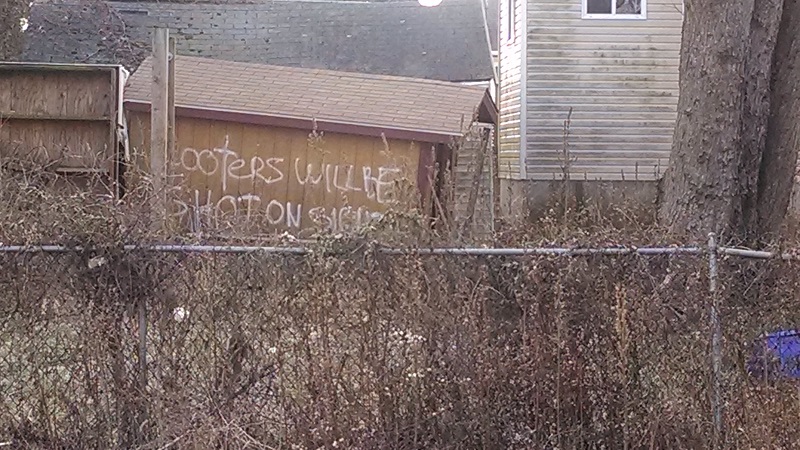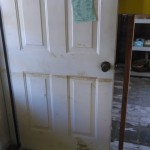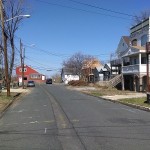
By Synnove Bakke | The Save Jersey Blog
I went on a winter shell hunting trip to the beach with my daughter in January of this year, Save Jerseyans. We ended up in the Laurence Harbor section of Old Bridge. On this icy cold day, we didn’t find any shells, but I was encouraged to see a boardwalk being built and an open area of beach where it looked like the sand had been replaced.
As we were leaving, we drove along the beach section of Old Bridge and we happened upon a ghost town, a neighborhood with 25 houses all boarded up. We drove down an eerie looking street named ‘Cliffwood Way.’ I made the turn into the neighborhood and was met with a very tragic sight: many of the houses featured crudely-painted warnings to looters.
It’s almost 2 years since Superstorm Sandy. Why are those houses still in shambles? Are they condemned and not going to be livable again or are the families waiting for Sandy Aid? It felt as if we had stepped onto the set of a disaster movie and not a community of the Jersey Shore.
I decided to come back and check in when the weather is warmer so I may find some of the home owners.
I had more luck finding people four months later.
One of three residents who spoke to me was Thomas Warren. A long time resident, Thomas’s home is at the end of the block away from the beach, and he was the only current owner that did experience severe flooding since his father had raised the foundation after a bad storm 50 years ago. He now finds himself living alone with his brother on an otherwise abandoned street.
Gary Sona is a friendly, fun guy who volunteered to give me a tour. While his home that he shared with his teenage son was completely condemned and uninhabitable after the storm, he’s maintained a very positive outlook on life. We noticed his house right away because his American flag was flying upside down on his porch; he says it’s a sign of distress.
“Here we are almost 2 years later and I still have no word on what will become of my house,” Gary explained. “We are waiting for the Government to buy us out, being that most of us cannot afford to build our houses to code, on stilts and the large flood insurance that follows a devastating storm like this.”
When I met her, Sheryl was cleaning up garbage strewn around on the empty lots… where her two houses used to stand. One house overlooked the ocean. She said the only help she ever received from the government was a $3,000 payment to help her move. Sheryl said she works for a living so she was cut off and penalized for being an active member of society. She feels it’s unfair that people working and contributing to taxes are penalized when tragedy strikes while others in society get much larger pay outs and monthly assistance.
Gary told me that the biggest house on the street (and the one house that saw practically no Sandy damage) was owned by a guy that subsequently picked up stakes and left town after the storm. Gary says he thinks the bank owns it now. The house is completely trashed inside, but he reports that’s because neighborhood kids have been using it for parties.
All three residents relayed their disgust with the fact that none of the help or buy out offers publicized by elected officials and media outlets have reached any of them while other neighboring towns such as South River and Sayreville have received more attention. Most of the homeowners want to be bought out so they can start fresh someplace else. They don’t know when they will be helped but hoped their houses are next on “the list.”
Thomas Warren said he and his brother might find out more about their fate in May. In the interim, they feel forgotten, neglected and overlooked by the Government and FEMA. It’s just taking far too long. Two years too long.
There’s reason for pessimism if you’ve watched the news. Apparently, the FBI is investigating how “FEMA has moved the lines on its flood maps to benefit hundreds of oceanfront condo buildings and million-dollar homes.” Rancor continues to broil over allotted funds including the revelation that “$4.8 million in relief funds went to help build an apartment tower in New Brunswick, a town that saw relatively little storm damage” and the story of a Belleville $6 million, 137 affordable senior housing development seemingly unrelated to Sandy in any meaningful way raised plenty of survivors’ blood pressure.
It’s hard to ignore how certain parties actually benefit from a bungled recovery effort, and most of them are Democrats who wants to see Chris Christie, the public face of the Sandy effort, fall flat upon his own face.
Governor Christie gave us an update on this last night on Ask The Governor with Eric Scott The Governor says help is on the way. As we suspected, part of the problem is that people are still on the waiting list because new federal money hasn’t been approved yet and won’t be approved until sometime next month.
The delay is taking its toll. Public satisfaction with New Jersey’s Superstorm Sandy recovery effort dropped below 50% for the first time since the storm hit nearly 18 months ago according to the latest Monmouth University/Asbury Park Press Poll. Nearly 3-in-4 Garden State residents say that the aid process has been too slow.
The Christie Administration committed $300 million in federal Sandy recovery funding for buyouts with the aim of acquiring hundreds of properties at risk for repeat flooding. I’m hoping that it translates to good news when I return to visit my new Old Bridge friends in late May to see what, if anything, has changed for them.













This is exactly why the government should never be involved in the recovery process. Waiting for the government to buy them out? The government should never do that. It’s tragic that people have such high hopes and demands of a group of corrupt politicians both in Trenton and DC. It’s not the governments responsibility to bail out private citizens or corporations, and frankly I don’t want my money in the form of taxes to go to rebuilding efforts. I want to donate directly to the people affected. This is exactly why we are in the mess we are in. Abolish FEMA once and for all and let the free market help each other.